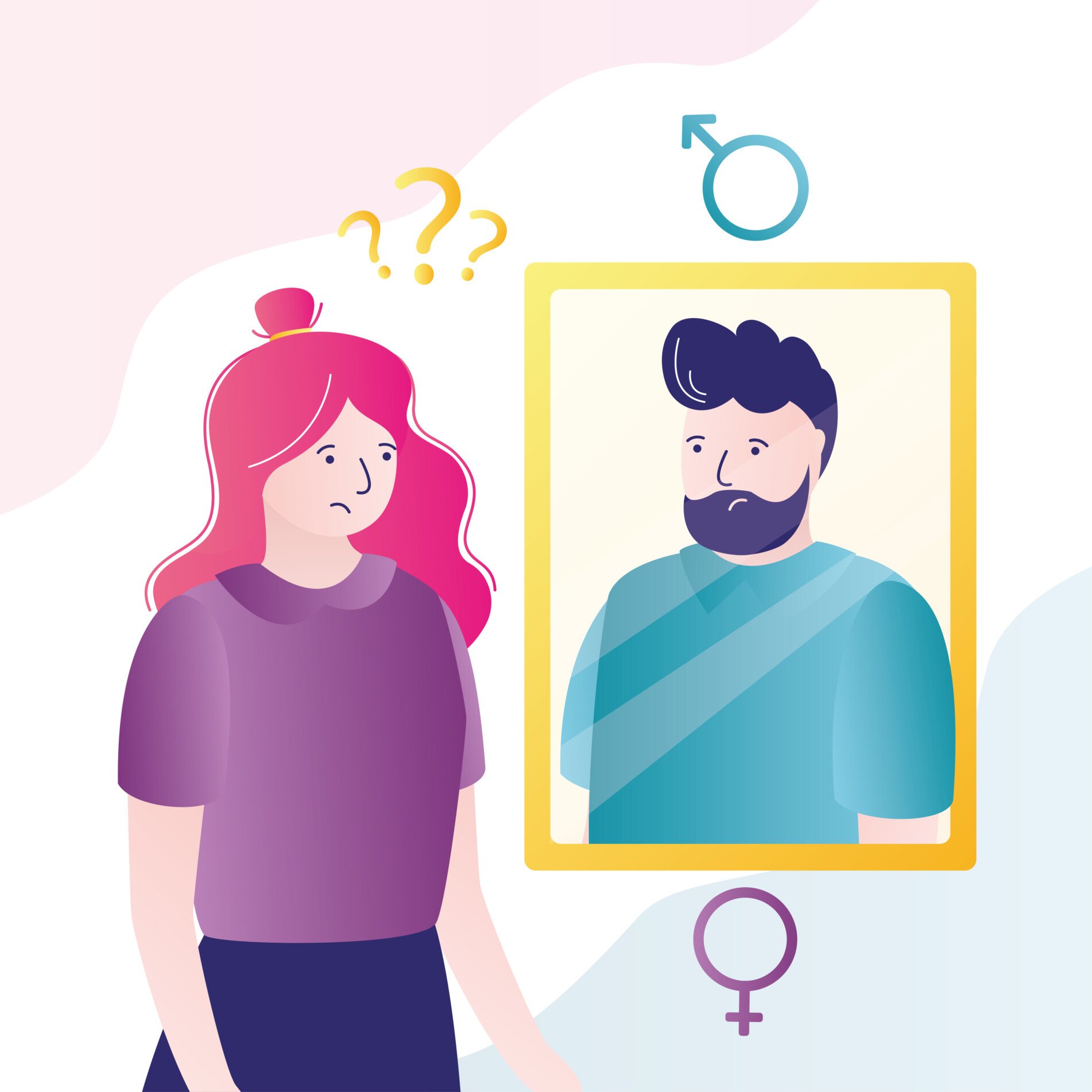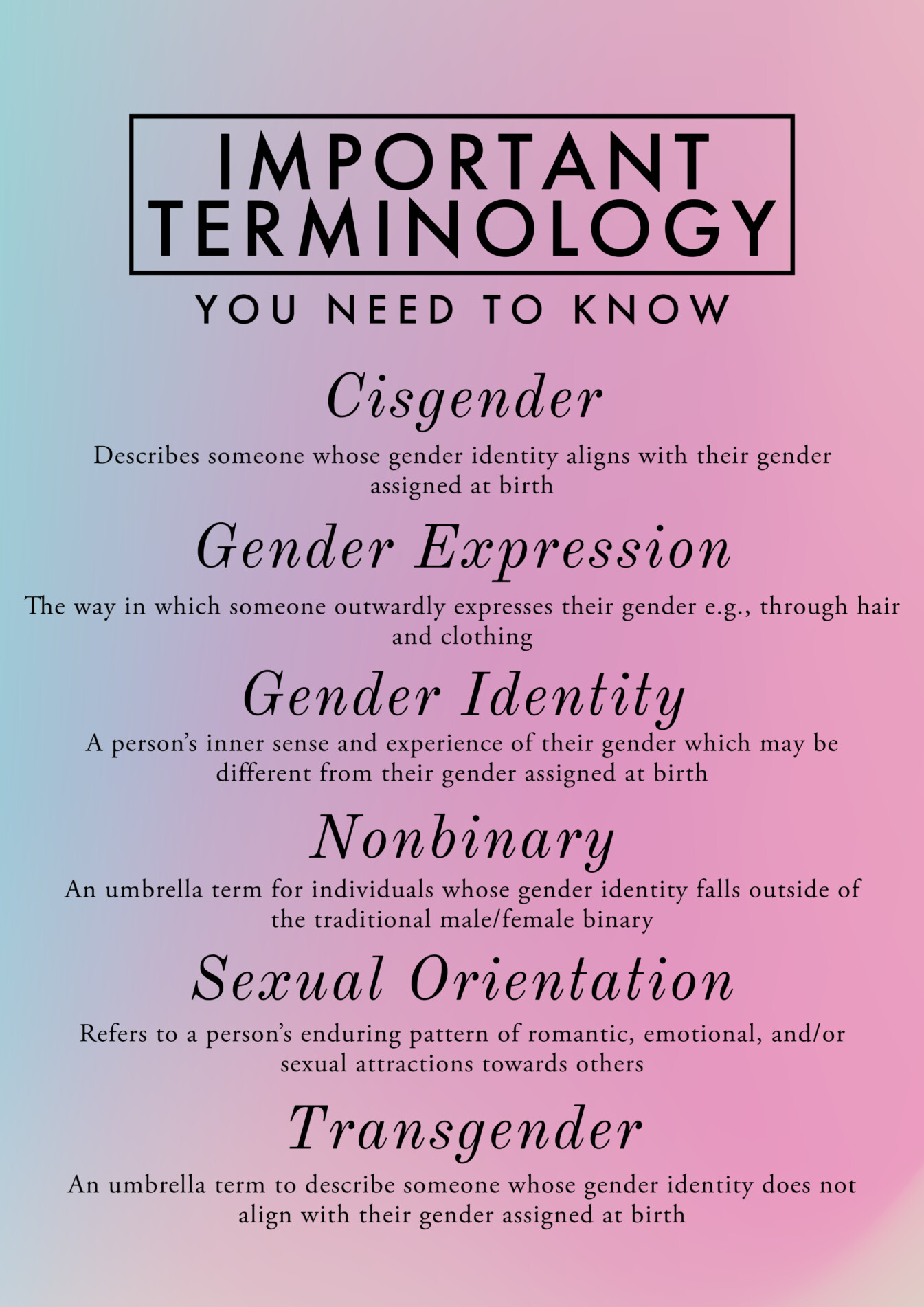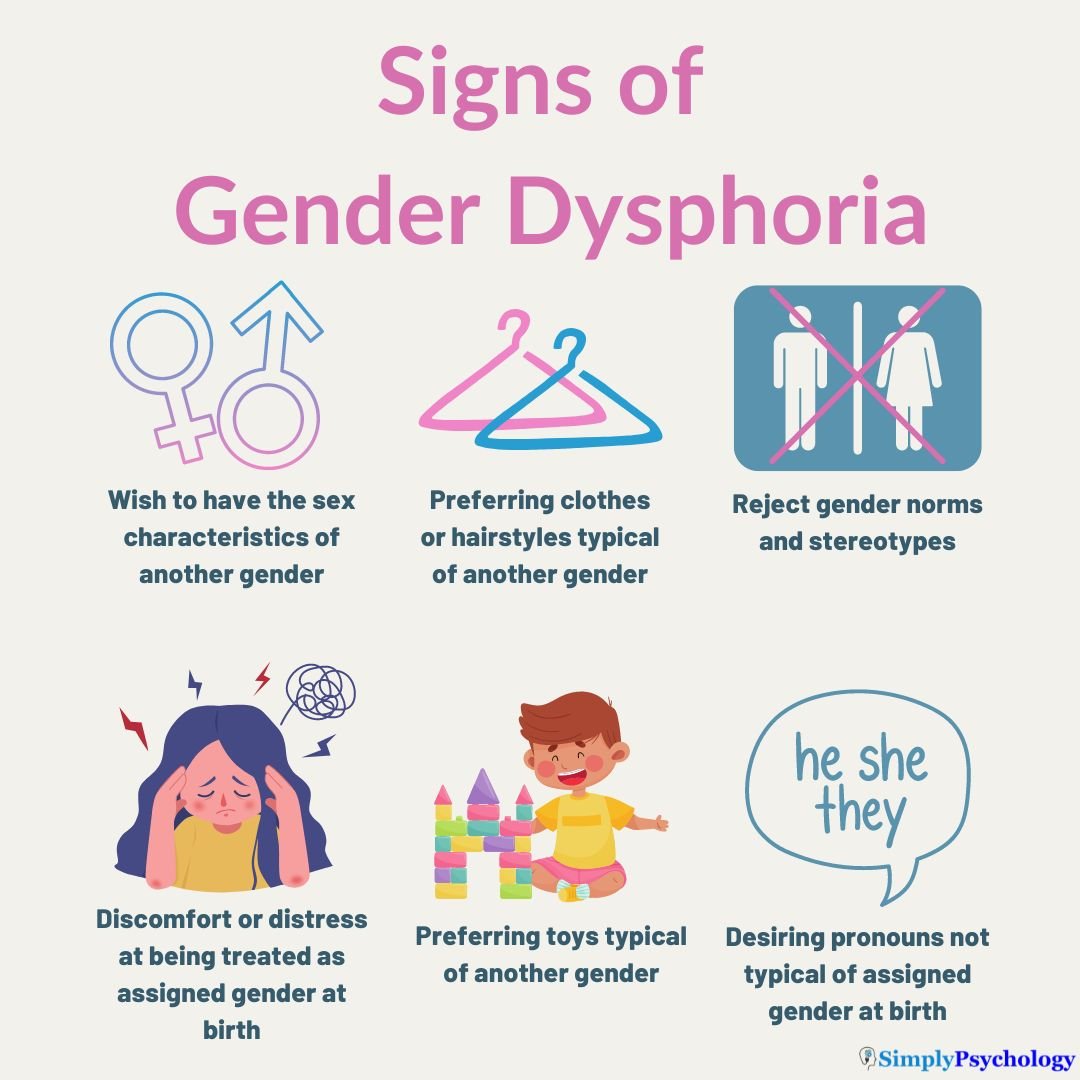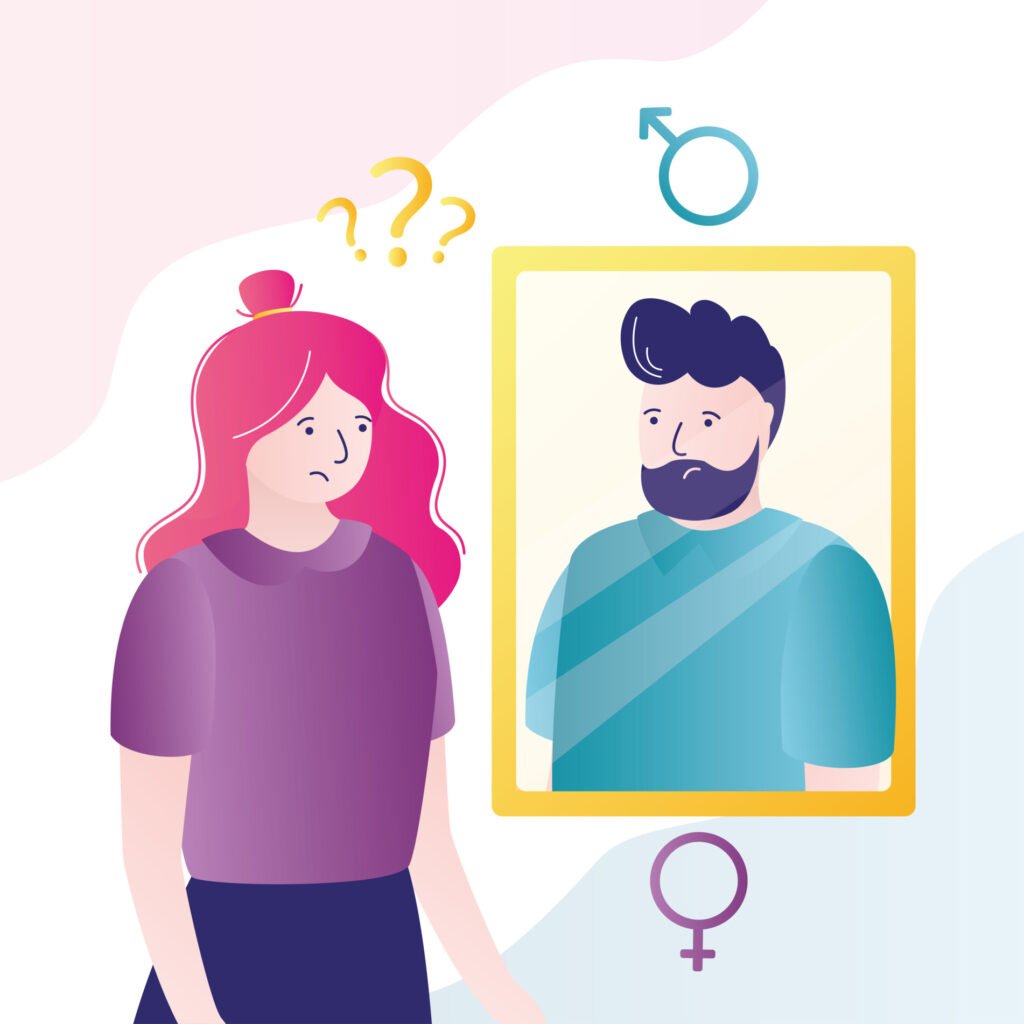On This Page:
Gender dysphoria refers to a condition in which an individual experiences discomfort or distress due to a conflict between their biological sex and gender identity.

This may involve feeling like their gender identity does not align with the gender they were assigned at birth. The symptoms can vary widely, including depression, anxiety, social isolation, and a desire to alter one’s physical appearance to align with gender identity.
Those with gender dysphoria may feel uncomfortable and/or distressed over the conflict between their physical and sexual characteristics and how they feel and think about themselves.
For instance, an individual may feel distressed over their physically female characteristics if their gender identity is male.
This contrasts with cisgender individuals – those whose gender identity aligns traditionally with the gender or sex assigned to them at birth.

Many people experiencing gender dysphoria may identify as transgender, which is an umbrella term describing individuals whose gender identity or gender expression differs from the sex or gender they were assigned at birth.
Some of those who are transgender do not consider themselves as matching a binary gender category of strictly male or female. Terms such as gender non-conforming and gender fluid are increasingly being used for those who are non-binary.
It is worth noting that not all people who are transgender experience gender dysphoria.
Gender identity and expression differ from sexual orientation (the type of people one is sexually attracted to). Sexual orientation is just as diverse for those who are transgender and gender non-conforming as it is for cisgender individuals.
What are gender norms?
Those experiencing gender dysphoria may also experience distress over traditional gender norms. Gender norms can be psychosocial factors such as verbal labeling (e.g., using terms ‘boy’ or ‘girl’), non-verbal gender-cuing (e.g., gender-specific clothing and hairstyles), and gender role expectations (e.g., getting pregnant).
‘Masculine’ and ‘feminine’ gender norms are culturally defined and vary across time and cultures. Although these gender norms may be imposed on people from a young age, it has been found that these factors are not determinative for those with gender dysphoria.
For instance, if a child has been encouraged to play with traditionally ‘boys’ toys throughout childhood, they may still experience a desire to identify as female.
Is the term ‘gender dysphoria’ problematic?
Some argue that the term ‘gender dysphoria’ itself can be stigmatizing and contribute to the pathologization of transgender individuals.
One of the primary concerns with the term “gender dysphoria” is that it medicalizes the experience of being transgender.
By framing it as a mental health condition, there is a risk of implying that being transgender is abnormal or a disorder. This perspective overlooks the fact that gender identity exists on a spectrum and is a normal variation of human diversity.
The term “gender dysphoria” is often used as a diagnostic criterion for accessing transgender-related healthcare and treatments, such as hormone therapy or gender-affirming surgeries.
This medicalization can reinforce the idea that being transgender is a medical problem that needs to be treated or fixed, rather than recognizing it as a valid and inherent aspect of a person’s identity.
Ultimately, the problematic nature of the term “gender dysphoria” lies in its potential to pathologize and stigmatize transgender individuals, framing their experiences solely in terms of distress and medical treatment rather than recognizing and celebrating the diversity of gender identities.
While this article discusses gender dysphoria in terms of how it is diagnosed in the DSM-5, it is worth keeping in mind these potential problems with the term itself.
What causes gender dysphoria?

Gender dysphoria often begins in childhood and may be identifiable as children expressing a wish to be of the opposite gender or wanting to express themselves in a gender-non-conforming way.
Although gender dysphoria usually begins early in life, some may not experience this dysphoria until after puberty or much later.
It has been found in many studies that there are brain similarities between those who experience gender dysphoria and the gender which they identify with (Byne et al., 2018; Ristori et al., 2020).
Likewise, in fetal development, as sexual differentiation of the genitals takes place in the first two months of pregnancy, and sexual differentiation of the brain begins in the second half of pregnancy, it has been suggested that these two processes can be influenced independently.
This implies that this is likely to result in gender dysphoria and that these feelings stem from a biological cause (Swaab & Garcia-Falgueras, 2009).
Signs of gender dysphoria

Below are some of the signs that may indicate that someone is experiencing gender dysphoria:
-
They may have a strong dislike of their sex characteristics and wish to have the sex characteristics of another gender.
-
They may have the desire to be treated as another gender.
-
They may have a preference for clothing or hairstyles of another gender.
-
They may reject toys or activities which are stereotypical of their assigned gender at birth.
-
They may express discomfort or distress at being treated as their assigned gender at birth.
-
They may reject gender norms and stereotypes.
-
They may desire to be addressed by pronouns that are not traditional of their assigned gender at birth.
-
They may wish to be addressed by a new name that is not traditional of their assigned gender at birth.
How is gender dysphoria diagnosed?
The Diagnostic and Statistical Manual of Mental Disorders (DSM-5) diagnoses gender dysphoria under two classifications: one for children and one for adolescents and adults.
For adolescents and adults, the DSM-5 criteria define gender dysphoria as a marked incongruence between one’s experienced/expressed gender and their assigned gender, lasting for at least six months and as manifested by at least two of the following:
-
A significant incongruence between one’s experienced/expressed gender and their primary and/or secondary sex characteristics.
-
A strong desire to remove one’s primary and/or secondary sex characteristics.
-
A strong desire for the primary and/or secondary sex characteristics of the opposite gender.
-
A strong desire to be of a different gender.
-
A strong desire to be treated as another gender.
-
A strong belief that they have the behaviors, feelings, and reactions that are characteristic of their preferred gender.
To meet these criteria, the condition must also be associated with clinically significant distress or impairment in social, occupational, or other important areas of functioning.
The DSM-5 defines gender dysphoria in children as a marked incongruence between one’s experienced/expressed gender and assigned gender, which must have also lasted for at least six months and is manifested by at least six of the following:
-
A strong desire to be of another gender or insistence that they are of another gender.
-
A strong preference for clothing that is typically associated with the opposite gender.
-
A strong preference for cross-gender roles in make-believe play or fantasy play.
-
A strong preference for toys, games, or activities that are stereotypically used by another gender.
-
A strong preference for playmates of another gender.
-
A strong rejection or avoidance of toys, games, or activities which are stereotypical of their assigned gender.
-
A strong dislike of one’s sexual characteristics.
-
A strong desire for the physical sex characteristics that match their experienced gender.
As with the diagnostic criteria for adolescents and adults, the condition must also be associated with clinically significant distress or impairment in social, occupational, or other important areas of functioning.
Challenges faced by people who experience gender dysphoria

Many individuals throughout history would have been considered transgender today.
There are also cultures around the world that recognize more than two genders. Therefore, people who do not identify as a different gender from their assigned gender have always existed throughout time and places.
However, there is often still a stigma attached to individuals who do not conform to their assigned gender at birth, especially in Western cultures.
Healthcare challenges
Those with gender dysphoria who choose to pursue medical treatments such as hormone therapy or breast removal may face some challenges.
Depending on the country they live in, they may have difficulty accessing appropriate healthcare or insurance to cover their medical costs. There may also be a long waiting list, or they may not be able to afford the treatment in general.
19th and 20th century takes on gender variance, and views of appropriate treatment were pathologizing and highly stigmatizing to trans people.
While mainstream psychiatry is more affirming of gender variance today, trans people may still experience health professionals who still adhere to outdated and stigmatizing theories and approaches to treatment.
Individuals may feel like they have to present as meeting all the criteria of gender dysphoria to their healthcare provider in order to receive the support they need:
“[I] feel very, like, trapped by my doctor into presenting a certain way and if I even deviate from that a little bit then I won’t have my options…Like, If I don’t do this the right way my doctor’s going to take away what I need, which is not a very nice way to have to interact with your doctor”
Interview extract from Brooker & Loshak (2020).
Discrimination
As there still exists a stigma associated with trans people, or anyone experiencing gender dysphoria, this can provide many challenges for these individuals. There is often an increased risk of bullying, violence, and discrimination.
People with gender dysphoria may be faced with offensive comments and language from those with outdated views, which could be damaging to the mental health of these individuals.
Those of school age may refuse to attend school for fear of bullying from other students or being discriminated against by teachers, whereas adults may not attend their job for fear of comments from co-workers.
Lack of support
Some people who experience gender dysphoria may also lack social support from their family or peers. Some may be too afraid to discuss their discomfort with members of their household for fear of losing those relationships.
Family members or friends may not accept the individual or be reluctant to believe that gender dysphoria is real. Some individuals, especially those who are younger, may find themselves stuck in a household where they do not feel accepted or that they cannot be their real selves.
Mental health challenges
Due to all the challenges that may be experienced, it is not uncommon for those with gender dysphoria to have accompanying mental health issues such as anxiety disorders, depression, or substance misuse disorders.
They may also have a negative self-image and feel uncomfortable about their appearance if what they see about themselves does not match their gender identity.
There is also a higher risk of suicide and self-harm for those who experience gender dysphoria. One study found that 48.3% of these individuals had experienced suicidal thoughts, and 23.8% had attempted suicide at least once (Garcia-Vega et al., 2018).
Experiencing mental health issues may also make it more difficult for those experiencing gender dysphoria to access the gender-affirming support they need, as described by one individual:
“When I first stated transitioning, I was experiencing a lot of issues with …mainly depression and a lot of thoughts of suicide…I didn’t want to say anything that would potentially be a barrier to me starting hormones…So I remember at the time thinking, how do I convey to the doctor…that I identify with these symptoms [of gender dysphoria] without appearing…mentally unhealthy”
Interview extract from Brooker & Loshak (2020).
Can gender dysphoria be treated?
Treatment for those with gender dysphoria focuses on helping the individual explore their gender identity and find a gender role that is comfortable for them and eases distress.
Treatment needs to be individualized, as what may help one person may not help another. Some people may choose to change their gender expression, such as wearing clothing they feel best represents their gender, changing their hairstyle, or changing their name.
However, some people may choose to have medical procedures, hormone therapy, or behavioral therapy as their choice of treatment.
Overall, each person’s experience is different and they are many different ways that one can explore their gender identity and role.
Medical treatment
While this may not be the choice for everyone experiencing gender dyphoria, medical treatments are an option for many.
A main medical treatment includes hormone therapy. This involves taking either masculinizing or feminizing hormones (testosterone or estrogen), which can work to minimize secondary sex characteristics such as breasts or facial hair.
Hormone treatment can help to lessen the feelings of gender dysphoria but can also come with some side effects.
There may be changes in libido, such as this increasing for those taking masculinizing hormones and reducing with feminizing hormones.
In rarer cases, these hormones can bring about manic and hypomanic symptoms, as well as psychotic symptoms, especially if there is an underlying psychiatric condition.
Another medical treatment is surgery. This can include feminizing or masculinizing surgery to change the breasts, genitalia, facial features, and body contouring.
There are treatments available that could enable individuals to transition to another gender if they so wished fully. Not everyone who experiences gender dysphoria will want to transition to their gender completely; some may want only to change secondary sex characteristics and not their genitalia.
Depending on the healthcare in each country will determine the procedure of opting for surgery. Usually, an in-depth discussion with health professionals is required to determine whether gender dysphoria is present.
Physical and mental health examinations may take place, including a look into personal and family medical history and whether the individual is likely to manage surgical procedures.
Health professionals may want evidence that gender dysphoria is persistent and well-documented and that the individual can make fully informed decisions and consents to treatment.
Behavioral therapy
The aim of behavioral therapy is not intended to alter the individual’s gender identity but to improve their psychological well-being and quality of life.
Behavioral therapy can be used alongside other types of treatment, or it can be used on its own if the individual does not want to undertake any medical treatments.
This therapy can include individual, couple, family, and group counseling and is tailored depending on the needs of the individual. This therapy may help individuals to:
-
Explore their gender identity
-
Build a support network
-
Become comfortable expressing their gender identity
-
Learn to accept themselves
-
Tackle any psychological or emotional impacts of gender dysphoria
-
Make informed decisions about any medical treatments they may wish to have
-
Find a safe way to come out to their family, friends, colleagues, or other contacts
As well as helping individuals with their gender dysphoria, behavioral therapy can also help to treat some of the mental health conditions which individuals may have alongside their dysphoria such as anxiety and depression.
Improving the well-being of those with gender dysphoria
There are many ways that someone with gender dysphoria may improve their well-being alongside or without treatment. Again, these can depend on the person as they may be suitable for one person but not another.
Name change
Some people with gender dysphoria may wish to change their name to one that matches their gender identity. This can be completed legally with parental permission or when they reach an age where they can do this themselves.
They may not want to change their name legally but will ask others to refer to them by the new name they have chosen.
Pronoun change
Some people with gender dysphoria may also choose to adopt a new pronoun.
These can be varied from switching to she/her, he/him or some people may prefer gender-neutral pronouns such as they/them. As a family member, friend, co-worker, or other contacts, using the chosen name and pronouns of an individual can help them feel validated and supported.
Support from family and friends
As close contacts of someone with gender dysphoria, it may really benefit the well-being of the individual to discuss with them how they are feeling and what they may or may not wish to change in their lives to ease their dysphoria.
This discussion could include asking questions as to the correct way to address the individual and what, if any, treatments they may wish to undergo.
A supportive network around the individual could improve their well-being so they do not feel isolated.
Support groups
Individuals with gender dysphoria may wish to join support groups specifically for gender dysphoria, transgender, or non-binary individuals.
This can be a good way to meet similar individuals who can give each other advice, make new friends, or listen to any issues they may face.
Other
Below is a list of some other steps people with gender dysphoria can take to ease their dysphoria and promote their well-being:
-
Voice and communication training to match the vocals of their gender
-
Breast binding or padding
-
Hair removal or transplantation
-
Genital tucking or packing
-
Changing aesthetics, such as applying makeup or changing clothing to match their gender identity
Of course, each individual who is experiencing gender dysphoria will differ in how they can improve their well-being. Some individuals may find some self-support methods work better over others. It is all about finding the right methods that suit the individual.
Further Information
References
American Psychological Association. (2015). Guidelines for psychological practice with transgender and gender nonconforming people . American Psychologist, 70(9), 832-864.
Brooker, A. S., & Loshak, H. (2020). Gender affirming therapy for gender dysphoria: a rapid qualitative review.
Craig, S. L., Austin, A., Levenson, J., Leung, V. W., Eaton, A. D., & D’Souza, S. A. (2020). Frequencies and patterns of adverse childhood events in LGBTQ+ youth. Child abuse & neglect, 107, 104623.
Jacobson, R., Cohen, H., & Diamond, G. M. (2016). Gender atypicality and anxiety response to social interaction stress in homosexual and heterosexual men. Archives of sexual behavior, 45(3), 713-723.
MacMullin, L. N., Bokeloh, L. M., Nabbijohn, A. N., Santarossa, A., van der Miesen, A. I., Peragine, D. E., & VanderLaan, D. P. (2021). Examining the Relation Between Gender Nonconformity and Psychological Well-Being in Children: The Roles of Peers and Parents. Archives of Sexual Behavior, 50(3), 823-841.
Roberts, A. L., Rosario, M., Corliss, H. L., Koenen, K. C., & Austin, S. B. (2012). Childhood gender nonconformity: A risk indicator for childhood abuse and posttraumatic stress in youth. Pediatrics, 129(3), 410-417.
Spivey, L. A., & Prinstein, M. J. (2019). A preliminary examination of the association between adolescent gender nonconformity and suicidal thoughts and behaviors. Journal of abnormal child psychology, 47(4), 707-716.
Toomey, R. B., Ryan, C., Diaz, R. M., Card, N. A., & Russell, S. T. (2013). Gender-nonconforming lesbian, gay, bisexual, and transgender youth: school victimization and young adult psychosocial adjustment.

